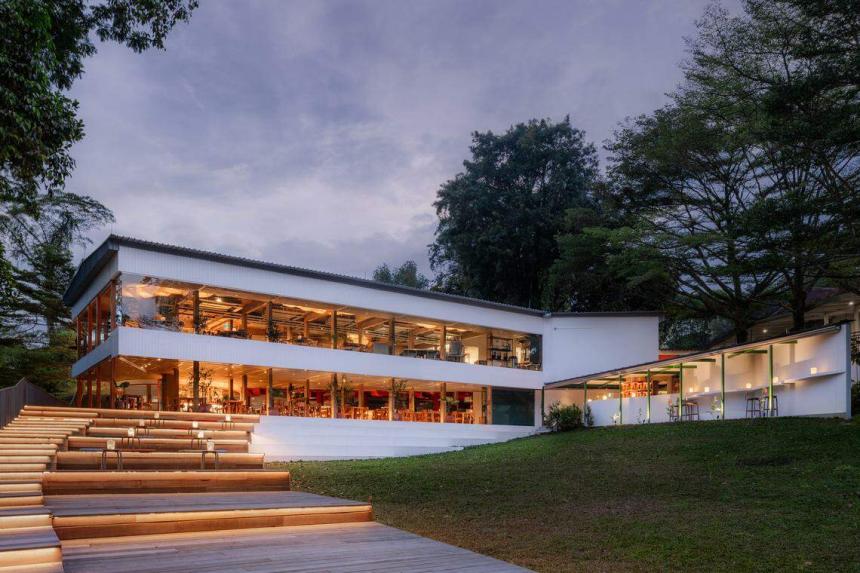SINGAPORE - Unusually, a 1970s modernist block that was once part of the Civil Service Club (CSC) has been restored and repurposed for a chic lifestyle hub in Dempsey. With a deft hand, international architectural firm OMA has shown that some not-so-old buildings may be worth preserving.
The building, 25B Dempsey Road, ceased to be a club when CSC moved out of the premises in 2006. It is now the Air Circular Campus and Cooking Club (Air), which includes a restaurant.
The design was by OMA, a global practice based in the Netherlands and known in Singapore for the award-winning The Interlace, a condominium in Depot Road.
Managing partner David Gianotten says his firm was given permission by the planning authorities to redesign the block, as it was not considered to be of architectural heritage value. But the design team, which included OMA associate Shinji Takagi, decided to keep much of the original building.
Mr Gianotten adds: “The block is not a conservation building, but we decided to treat it like one.”
The building is a concrete and glass two-storey structure shaped like a shoebox with a kink at one end. The architect who designed it is not known.
While looking more pristine after a spruce-up, the facade remains largely unchanged. With its original columns exposed, it even bears some resemblance to modernist architect Le Corbusier’s Villa Savoye (1931) in France.

OMA’s design intervention means the building will likely be saved from demolition for now. Interestingly, the driving force behind Air was not the preservation of its architectural history, but sustainable design.
This can be about repurposing and adapting old buildings, instead of creating demolition waste and building something new. OMA decided to make minimal changes to reduce construction waste.
Any architectural intervention would have to reveal the old building’s valuable elements.
While reconfiguring an old building for new purposes is challenging, Mr Gianotten says: “We think transforming the existing built substance to something new and ready for the future is a better approach than discarding something not deemed valuable and building something fully new.”
Air, which sits on a 3,700 sq m site off Holland Road near the Singapore Botanic Gardens, has a total floor area of 700 sq m.

Guests enter via a curved, 100m timber walkway made of recycled wood. This path divides the site. A garden of edible plants and herbs sits on one side. A sprawling lawn, available for picnics, lies on the other.
The circulation path defined by the walkway extends into the heart of the building, and establishes the organisation of the spaces within.
On the first level, there is an open kitchen and a main dining area that faces the lawn. Sliding glass panel doors turn the space into an indoor-outdoor dining space.
The second level features a more intimate dining area facing the lawn, a cooking school and food research zones. Frameless glass floor-to-ceiling windows offer panoramic views of the lush site.

Another design intervention by OMA is the addition of a cylindrical structure at the rear of the building. It consolidates the front-of-house and back-of-house programmes, including the staircases for the guests and the staff, a bar, another kitchen and a machine room.

Air was opened in January by Mr Ronald Akili, co-founder of the Indonesian hospitality brand Potato Head, and renowned chefs Matthew Orlando of Amass restaurant in Copenhagen and Will Goldfarb of Room4Dessert in Bali.
OMA has worked with Mr Akili since 2013 on projects such as the Potato Head Studios resort in Bali.
Mr Akili says the intention for Air was not to open another Michelin-starred restaurant. Like his hospitality business in Bali, the goal for Air is to be zero-waste, and this includes upcycling waste into design objects.
So, apart from repurposing the old building, the furniture at Air is also made from repurposed and recycled materials. Some materials were sourced from an earlier collaboration between OMA and Potato Head – the N*thing Is Possible exhibition at Singapore’s National Design Centre in 2022.
That show was co-curated by OMA and Potato Head, and highlighted works by artists and artisans on the theme of zero waste. Japanese architect Kengo Kuma was among the participants.
For the exhibition, Mr Kuma created a timber installation reminiscent of molecular structure, made of recycled wood.

When Mr Andreu Carulla was asked to design the furniture for Air, the Spanish designer, who had also taken part in N*thing, decided to repurpose Mr Kuma’s installation.
This installation was made of modular timber poles ranging in length from 36cm to 100cm. In that light, Mr Carulla’s design for the chairs on the first level also took on a modular aesthetic of assembled parts.
The tables, made of the same recycled wood, have seemingly irregular edges, but can fit together like pieces of a puzzle to form long tables.
For the dining area on the second level, Mr Carulla designed chairs with a 1970s vibe. The frames are made of aluminium, then wrapped with a material from recycled polystyrene foam, and made to look like tactile strips of cane.

The table lamps, which have organic shapes, are made of recycled high-density polyethylene plastic bottles and containers.
All this sets the stage for a menu that is also all about zero waste and sustainability. Chefs Orlando and Goldfarb have been described as “stalwarts of sustainability”, so a dish like The Whole Grouper for Two ($64) means just that – head, bones and all.
There is also the Re-incarnated Chocolate ($18), a dessert made without chocolate. Instead, it is made from cocoa husks and cascara – a by-product of coffee – and a caramel made with banana skins.
And, like so many things at Air – including the building – the dessert was brought back to life from the brink of becoming rubbish in a landfill.


